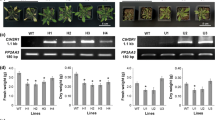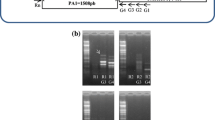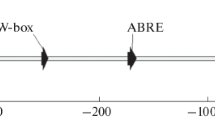Abstract
To study the pattern of gene regulation of the plastid chaperonin 60β gene family a chimaeric gene was constructed fusing the 5′-flanking region of the chaperonin 60β B3 gene to the β-glucuronidase reporter gene. Histochemical and fluorometric analysis of the GUS activity present in transgenic plants harbouring this gene construct showed that the B3 promoter is expressed in leaves, stem, petioles and several flower tissues. The pattern of cell type-specific expression in stems and flowers was found to be developmentally regulated. Expression of the B3 promoter was found not to be heat-inducible, but highly repressed by wounding. The rapid decay in GUS activity upon wounding indicates that, at least under some physiological conditions, the gene product of this reporter gene is not as stable as has been previously thought.
Similar content being viewed by others
References
Cheng M, Hartl F, Martin J, Pollock R, Kalousek F, Neupert W, Halberg E, Horwich A: Mitochondrial heat-shock protein Hsp60 is essential for assembly of proteins into yeast mitochondria. Nature 337: 620–625 (1989).
Ellis J, van der Vies S: Molecular chaperones. Annu Rev Biochem 60: 321–347 (1991).
Gatenby AA: Protein folding and chaperonins. Plant Mol Biol 19: 677–687 (1992).
Gething MJ, Sambrook J: Protein folding in the cell. Nature 255: 33–45 (1992).
Goloubinoff P, Gatenby AA, Lorimer GH: GroE heat shock proteins promote assembly of foreign prokaryotic ribulose bisphosphate carboxilase oligimers in Escherichia coli. Nature 337: 44–47 (1989).
Goloubinoff P, Christeller JT, Gatenby AA, Lorimer GH: Reconstitution of active oligomeric ribulose bisphosphate carboxylase from an unfolded state depends on two chaperonin proteins and Mg-ATP. Nature 342: 884–889 (1989).
Hemmingsen SM, Ellis RJ: Purification and properties of ribulose bisphosphate carboxylase large subunit binding protein. Plant Physiol 80: 269–276 (1986).
Hemmingsen SM, Woolford C, van der Vries SM, Tilly K, Dennis DT, Georgopoulos CP, Hendrix RW, Ellis RJ: Homologous plant and bacterial proteins chaperone oligomeric protein assembly. Nature 333: 330–334 (1988).
Horsch R, Fry J, Hoffman N, Eichholtz D, Rogers S, Fraley R: A simple and general method of transferring genes into plants. Science 227: 1229–1231 (1985).
Jefferson RA, Kavanagh TA, Bevan MW: GUS fusions: β-glucuronidase as a sensitive and versatile gene fusion marker in higher plants. EMBO J 6: 3901–3907 (1987).
Koll H, Guirad B, Rassow J, Ostermann J, Horwich A, Neupert W, Hartl F: Antifolding activity of Hsp60 couples protein import into mitochondrial matrix with export to the intermembrane space. Cell 68: 1163–1175 (1992).
Kusukawa N, Yura T: Heat shock protein GroE of Escherichia coli: key protective roles against thermal stress. Genes Devel 2: 874–882 (1988).
Lecker S, Ziegelhoffer T, Bassford P, Kumamoto C, Wickner W: Three pure chaperone proteins of Escherichia coli, SecB, trigger factor and GroEL form soluble complexes with precursor proteins in vitro. EMBO J 8: 2703–2709 (1989).
Li Y, Hagen G, Guilfoyle TJ: An auxin-responsive promoter is differentially induced by auxin gradients during tropisms. Plant Cell 3: 1167–1175 (1992).
Newman TC, Ohme-Takagi M, Taylor CB, Green PJ: DST sequences highly conserved among plant SAUR genes, target reporter transcripts for rapid decay in tobacco. Plant Cell 5: 701–714 (1993).
Phillips G, Silhavy T: Heat-shock proteins DnaK and GroEL facilitate export of LacZ hibrid proteins in E. coli. Nature 344: 882–884 (1990).
Pichon M, Journet E-T, Dedieu A, de Billy F, Trouchet G, Barker DG: Rhizobium meliloti elicits transient expression of the early nodulin gene ENOD 12 in the differentiating root epidermis of transgenic alfalfa. Plant Cell 4: 1199–1211 (1992).
Pitto L, Gallie DR, Walbot V: Role of the leader sequence during thermal repression of translation in maize, tobacco and carrot protoplasts. Plant Physiol 100: 1827–1833 (1992).
Reading DS, Halberg RL, Myers AM: Characterization of yeast Hsp60 gene for a mitochondrial assembly factor. Nature 337: 665–659 (1989).
Vivekanda J, Drew MC, Thomas TL: Hormonal and environmental regulation of the carrot lea-class gene Dc3. Plant Physiol 100: 576–581 (1992).
Wada M, Itikawa H: Participation of Escherichia coli K-12 GroE products in the synthesis of cellular DNA and RNA. J Bact 157: 694–696 (1984).
Zabaleta E, Oropeza A, Jiménez B, Salerno G, Crespi M, Herrera-Estrella L: Isolation and characterization of genes encoding chaperonin 60β from Arabidopsis thaliana. Gene 111: 175–181 (1992).
Gallagher SR: Gus protocols: using the GUS gene as a reporter of gene expression. Academic Press, New York (1992).
Lindquist S, Craig EA: The heat shock proteins. Annu Rev Genet 22: 631–677 (1988).
Author information
Authors and Affiliations
Rights and permissions
About this article
Cite this article
Zabaleta, E., Assad, N., Oropeza, A. et al. Expression of one of the members of the Arabidopsis chaperonin 60β gene family is developmentally regulated and wound-repressible. Plant Mol Biol 24, 195–202 (1994). https://doi.org/10.1007/BF00040585
Received:
Accepted:
Issue Date:
DOI: https://doi.org/10.1007/BF00040585




